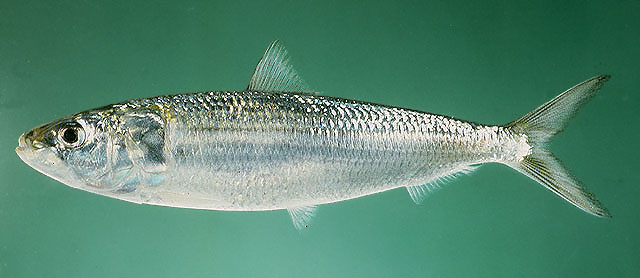| Dorosomatidae (Gizzard shads and sardinellas) |
| 23 cm SL (male/unsexed); max.weight: 200.0 g; max. reported age: 3 years |
|
pelagic-neritic; marine; depth range 20 - 200 m, oceanodromous |
| Indian Ocean: northern and western parts only, Gulf of Aden, Gulf of Oman, but apparently not Red Sea or the Persian Gulf, eastward to southern part of India, on eastern coast to Andhra; possibly to the Andaman Islands. Thus, studies pertaining to this species from the Philippines or Indonesia probably refer to Sardinella lemuru. |
|
Dorsal spines (total): 0-0; Dorsal soft rays (total): 13-21; Anal spines: 0-0; Anal soft rays: 12-23; Vertebrae: 45-49. Body sub-cylindrical; a faint golden spot behind gill opening, followed by a faint golden mid-lateral line; a distinct black spot at hind border of gill cover (absence of pigment). Distinguished from all clupeids in the northern Indian Ocean by its pelvic fin ray count of i 8; from S. neglecta and S. lemuru by its longer head and more lower gill rakers. No prominent keel. See also Refs. 3683, 818 and 393 . |
| Coastal pelagic (Ref. 68964). Forms schools in coastal waters and strongly migratory. Feeds mainly on phytoplankton (especially diatoms) and small crustaceans (Ref. 30573). Breeds once a year off western coasts of India when temperatures and salinity are low during the southwest monsoon months. Spawning peaks in August-September. Occurs at temperatures of 22.0-28.0 °C (Ref. 3689). Marketed fresh, dried and dried-salted. Also sold smoked and canned (Ref. 9987). Also made into fish meal and fish balls. |
|
Least Concern (LC); Date assessed: 20 December 2019 Ref. (130435)
|
| harmless |
|
Dominant clupeid in central and southern Oman (Ref. 11441). Known from Dimaniyyat Islands (Ref. 129713). Also Ref. 188. Significant contributor to Omani fisheries. Constitutes 80% of total small pelagic landings and 40% of overall catch, averaging 30 to 50 thousand tons annually. Valued as food fish and fodder for cattle. Caught using beach seines, boat seines, gillnets and castnets (Ref. 9773) |
Source and more info: www.fishbase.org. For personal, classroom, and other internal use only. Not for publication.
